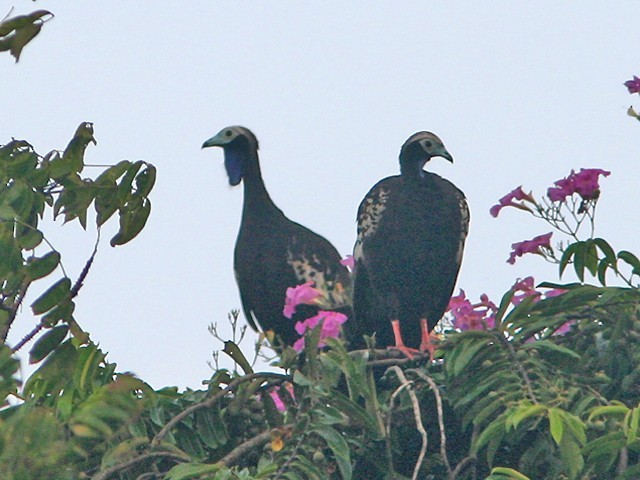Trinidad Piping Guan
A species of Guan Scientific name : Pipile pipile Genus : Guan
Trinidad Piping Guan, A species of Guan
Botanical name: Pipile pipile
Genus: Guan
Content
Description General Info
 Photo By Don Roberson
Photo By Don Roberson Description
This is a medium-sized cracid, 60 cm in length, and similar in general appearance to a turkey, with a thin neck and small head. It is mainly black with a purple gloss. The large crest is blackish, edged with white, and there are large white wing patches. The bare face and wattle are blue, and the legs are red. The Trinidad piping guan's call is a thin piping. The wings whirr in flight. 
Size
69 cm
Nest Placement
Tree
Feeding Habits
Trinidad Piping Guan predominantly consumes fruits and seeds (86.6%), complemented by leaves (6.7%) and invertebrates (6.7%). It forages in small arboreal groups and is known to feed on a wide variety of plant species, occasionally taking ripe coffee beans. Unique for its all-day feeding, trinidad Piping Guan also consumes water from streams and epiphytes.
Habitat
Trinidad Piping Guan primarily inhabits remote, tall primary forests characterized by a closed canopy, rich with vines and epiphytes, and notably sparse ground cover. These environments typically feature steep hilly areas, deep valleys, and abundant watercourses. The species shows a preference for rainforests and semi-evergreen seasonal forests, and while mainly associated with less disturbed habitats, there are some observations of trinidad Piping Guan in second growth forests, shade-coffee plantations, and cultivated areas near primary forests.
Dite type
Frugivorous
General Info
Feeding Habits
Bird food type

Fruit
Species Status
This species is found only in Trinidad where it was once abundant throughout the Northern Range and the southern Trinity Hills, and also occurred in lowland areas such as the Nariva Swamp and Aripo Savannas. It is threatened by illegal hunting and to a lesser extent by habitat destruction. It is now absent from the lowlands, and almost certainly extinct in the Trinity Hills where surveys have failed to find it since 1994. There is a credible report of a sighting in 2000 in the Northern Range and there are 200 to 350 km (77 to 135 sq mi) of suitable habitat there so the International Union for Conservation of Nature has rated the bird as "critically endangered". 

 Photo By Don Roberson
Photo By Don Roberson